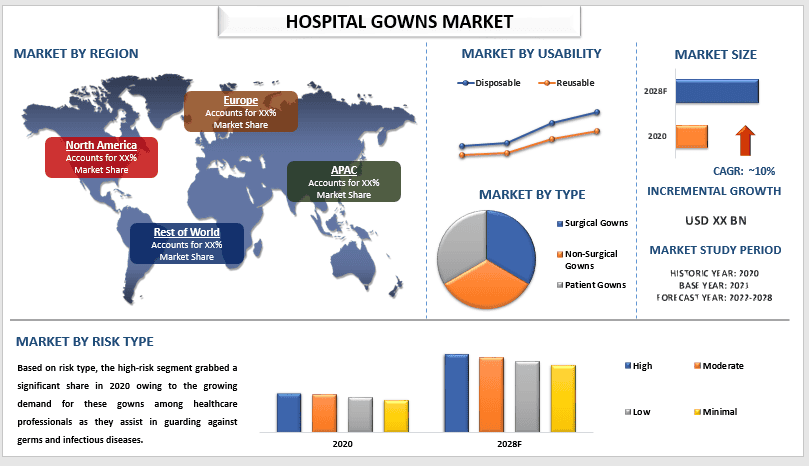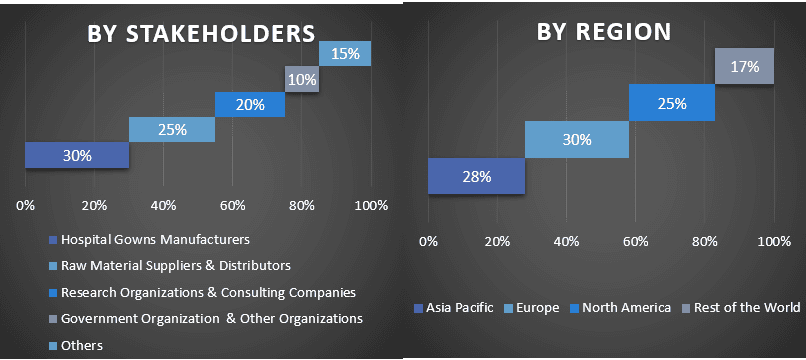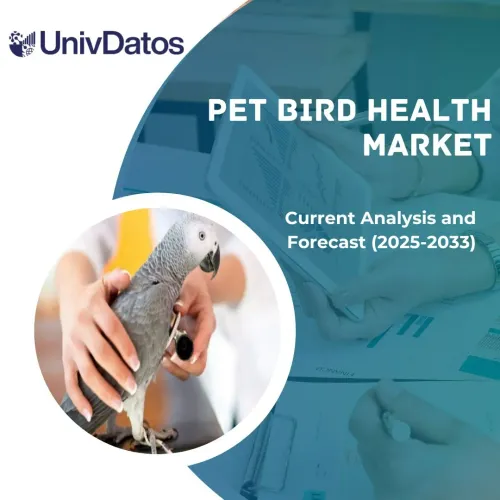- Home
- Chi siamo
- Settore
- Servizi
- Lettura
- Contattaci
Mercato dei camici ospedalieri: analisi attuale e previsioni (2022-2028)
Enfasi su tipo (camici chirurgici, camici non chirurgici e camici per pazienti); Tipo di rischio (minimo, basso, moderato e alto); Usabilità (usa e getta e riutilizzabili); e Regione/Paese

Si prevede che il mercato globale dei camici ospedalieri cresca a un ritmo significativo di circa il 10% durante il periodo di previsione.I pazienti che ricevono cure o vengono ispezionati in una clinica o in un ospedale, così come i medici che eseguono procedure, indossano camici ospedalieri, che sono camici corti senza colletto allacciati sul retro. Il mercato dei camici ospedalieri è in crescita a causa del crescente numero di interventi chirurgici e dell'aumento dei casi di infezioni associate all'assistenza sanitaria (HAI) a causa della mancanza di precauzioni e igiene.Ad esempio, ogni anno 1,7 milioni di persone contraggono un'infezione durante un ricovero ospedaliero. Inoltre, quasi 98.987 persone negli Stati Uniti muoiono ogni anno a causa di HAI.Inoltre, fattori quali il crescente progresso tecnologico nel settore sanitario, l'aumento della spesa sanitaria e la rapida crescita del settore del turismo medico in tutto il mondo stanno anche guidando il mercato a livello globale.Ad esempio, secondo la Medical Tourism Association, quasi 14 milioni di persone in tutto il mondo viaggiano in diversi paesi in cerca di cure mediche all'anno. È un'attività che vale tra i 50 ei 70 miliardi di dollari.A causa di questi fatti e della crescente conformità agli standard internazionali per le procedure chirurgiche, si prevede che anche il mercato dei camici ospedalieri crescerà durante il periodo di previsione.
3M, Cardinal Health, Medline Industries Inc., Standard Textile Co. Inc., Angelica Corporation, AmeriPride Services Inc., Aramark Corporation, Dynarex Corporation, PRIMED Medical Products Inc., Stryker Corporation sono alcuni dei principali attori del mercato. Diverse fusioni e acquisizioni insieme a partnership sono state intraprese da questi attori per facilitare i clienti con camici ospedalieri.
Approfondimenti presentati nel rapporto
“Tra i tipi, la categoria dei camici chirurgici sarà testimone di un robusto CAGR durante il periodo di previsione”
In base al tipo, il mercato dei camici ospedalieri è segmentato in camici chirurgici, camici non chirurgici e camici per pazienti. Il segmento dei camici chirurgici ha rappresentato una quota di mercato significativa nel 2020 e si stima che crescerà rapidamente durante il periodo di tempo previsto. I camici chirurgici sono progettati per proteggere da varie contaminazioni e infezioni durante le procedure chirurgiche. La crescita di questo segmento può essere attribuita a un aumento del numero di persone affette da malattie croniche che portano a un aumento del numero di interventi chirurgici, unito a una crescente attenzione alla prevenzione delle infezioni contratte in ospedale.
“Tra i tipi di rischio, l'alto rischio detiene una quota significativa nel mercato nel 2020”
Sulla base del tipo di rischio, il mercato è suddiviso in minimo, basso, moderato e alto. Tra questi, l'alto rischio detiene una quota significativa nel mercato nel 2020. Ciò è dovuto principalmente alla crescente adozione di questi camici a causa dei vantaggi dei camici ad alto rischio come l'elevata resistenza alla trazione, la resistenza allo strappo e la traspirabilità. Tuttavia, il segmento dei camici a rischio minimo dovrebbe registrare una crescita considerevole nei prossimi anni in quanto sono ampiamente utilizzati nelle unità di base, nelle unità mediche standard, nell'isolamento standard e come camici di copertura per i visitatori.
“Tra l'usabilità, la categoria usa e getta sarà testimone di un robusto CAGR durante il periodo di previsione”
Sulla base dell'usabilità, il mercato dei camici ospedalieri è stato classificato in usa e getta e riutilizzabili. La categoria usa e getta sarà testimone di una maggiore adozione in quanto sono economicamente vantaggiosi e sono raccomandati rispetto ai camici riutilizzabili in termini di sicurezza e qualità. I camici usa e getta sono realizzati con materiali certificati ipoallergenici e dermatologici e servono a limitare il pericolo di infezione e contaminazione crociata tra i pazienti.
“Il Nord America deterrà una quota significativa nel mercato”
Per una migliore comprensione dell'adozione del mercato del settore dei camici ospedalieri, il mercato è analizzato in base alla sua presenza mondiale in paesi come Nord America (Stati Uniti, Canada, Resto del Nord America), Europa (Germania, Regno Unito, Francia, Spagna, Italia, Resto d'Europa), Asia-Pacifico (Cina, Giappone, India, Resto dell'Asia-Pacifico), Resto del mondo. Si prevede che il Nord America crescerà a un CAGR sostanziale durante il periodo di previsione. Ciò è dovuto principalmente a una crescente prevalenza di infezioni contratte in ospedale e al crescente uso di camici ospedalieri nella regione.
Motivi per acquistare questo rapporto:
- Lo studio include la dimensionamento del mercato e l'analisi delle previsioni convalidate da esperti chiave del settore autenticati.
- Il rapporto presenta una rapida panoramica delle prestazioni complessive del settore a colpo d'occhio.
- Il rapporto copre un'analisi approfondita dei principali pari del settore con particolare attenzione ai principali dati finanziari aziendali, al portafoglio prodotti, alle strategie di espansione e agli sviluppi recenti.
- Esame dettagliato dei driver, dei vincoli, delle tendenze chiave e delle opportunità prevalenti nel settore.
- Lo studio copre in modo completo il mercato in diversi segmenti.
- Analisi approfondita a livello regionale del settore.
Opzioni di personalizzazione:
Il mercato globale dei camici ospedalieri può essere ulteriormente personalizzato in base alle esigenze o a qualsiasi altro segmento di mercato. Oltre a ciò, UMI comprende che potresti avere le tue esigenze aziendali, quindi sentiti libero di metterti in contatto con noi per ottenere un rapporto che si adatti completamente alle tue esigenze.
Indice
Metodologia di ricerca per l'analisi del mercato dei camici ospedalieri (2022-2028)
L'analisi del mercato storico, la stima del mercato attuale e la previsione del mercato futuro del mercato globale dei camici ospedalieri sono stati i tre passaggi principali intrapresi per creare e analizzare l'adozione dei camici ospedalieri nelle principali regioni a livello globale. È stata condotta un'ampia ricerca secondaria per raccogliere i numeri storici del mercato e stimare le dimensioni del mercato attuale. In secondo luogo, per convalidare questi risultati, sono state prese in considerazione numerose scoperte e ipotesi. Inoltre, sono stati condotti anche ampi colloqui primari, con esperti del settore lungo la catena del valore del mercato globale dei camici ospedalieri. Dopo l'assunzione e la convalida dei numeri di mercato attraverso interviste primarie, abbiamo impiegato un approccio top-down/bottom-up per prevedere le dimensioni complete del mercato. Successivamente, sono stati adottati metodi di scomposizione del mercato e di triangolazione dei dati per stimare e analizzare le dimensioni del mercato dei segmenti e dei sottosegmenti del settore di riferimento. La metodologia dettagliata è spiegata di seguito:
Analisi delle dimensioni storiche del mercato
Fase 1: studio approfondito delle fonti secondarie:
È stato condotto uno studio secondario dettagliato per ottenere le dimensioni storiche del mercato del mercato dei camici ospedalieri attraverso fonti interne all'azienda comerelazioni annuali e bilanci, presentazioni delle prestazioni, comunicati stampa, ecc.e fonti esterne tra cuiriviste, notizie e articoli, pubblicazioni governative, pubblicazioni dei concorrenti, rapporti di settore, database di terze parti e altre pubblicazioni credibili.
Fase 2: Segmentazione del mercato:
Dopo aver ottenuto le dimensioni storiche del mercato del mercato dei camici ospedalieri, abbiamo condotto un'analisi secondaria dettagliata per raccogliere informazioni storiche sul mercato e quote per diversi segmenti e sottosegmenti per le principali regioni. I principali segmenti sono inclusi nel rapporto come tipo, tipo di rischio e usabilità. Ulteriori analisi a livello di paese sono state condotte per valutare l'adozione complessiva dei modelli di test in quella regione.
Fase 3: Analisi dei fattori:
Dopo aver acquisito le dimensioni storiche del mercato di diversi segmenti e sottosegmenti, abbiamo condotto un'analisi dettagliataanalisi dei fattoriper stimare le dimensioni attuali del mercato del mercato dei camici ospedalieri. Inoltre, abbiamo condotto un'analisi dei fattori utilizzando variabili dipendenti e indipendenti come vari tipi, tipi di rischio e usabilità dei camici ospedalieri. È stata condotta un'analisi approfondita degli scenari di domanda e offerta considerando le principali partnership, fusioni e acquisizioni, l'espansione del business e i lanci di prodotti nel settore del mercato dei camici ospedalieri in tutto il mondo.
Stima e previsione delle dimensioni attuali del mercato
Dimensioni attuali del mercato:Sulla base di approfondimenti fruibili dai 3 passaggi precedenti, siamo giunti alle dimensioni attuali del mercato, ai principali attori nel mercato globale dei camici ospedalieri e alle quote di mercato dei segmenti. Tutte le quote percentuali richieste, le divisioni e le scomposizioni del mercato sono state determinate utilizzando l'approccio secondario sopra menzionato e sono state verificate attraverso interviste primarie.
Stima e previsioni:Per la stima e la previsione del mercato, sono stati assegnati pesi a diversi fattori tra cui driver e tendenze, vincoli e opportunità disponibili per gli stakeholder. Dopo aver analizzato questi fattori, sono state applicate tecniche di previsione pertinenti, ad es. l'approccio top-down/bottom-up, per arrivare alle previsioni di mercato per il 2028 per diversi segmenti e sottosegmenti nei principali mercati a livello globale. La metodologia di ricerca adottata per stimare le dimensioni del mercato comprende:
- Le dimensioni del mercato del settore, in termini di ricavi (USD) e il tasso di adozione del mercato dei camici ospedalieri nei principali mercati a livello nazionale
- Tutte le quote percentuali, le divisioni e le scomposizioni dei segmenti e dei sottosegmenti di mercato
- Attori chiave nel mercato globale dei camici ospedalieri in termini di prodotti offerti. Inoltre, le strategie di crescita adottate da questi attori per competere nel mercato in rapida crescita
Validazione delle dimensioni e della quota di mercato
Ricerca primaria:Sono stati condotti colloqui approfonditi con i Key Opinion Leader (KOL) tra cui dirigenti di alto livello (CXO/VP, responsabili delle vendite, responsabili del marketing, responsabili operativi, responsabili regionali, responsabili nazionali, ecc.) in tutte le principali regioni. I risultati della ricerca primaria sono stati quindi riassunti e sono state eseguite analisi statistiche per dimostrare l'ipotesi dichiarata. Gli input della ricerca primaria sono stati consolidati con i risultati secondari, trasformando quindi le informazioni in approfondimenti utili.
Suddivisione dei partecipanti primari in diverse regioni

Ingegneria del mercato
La tecnica di triangolazione dei dati è stata impiegata per completare la stima complessiva del mercato e per ottenere numeri statistici precisi per ogni segmento e sottosegmento del mercato globale dei camici ospedalieri. I dati sono stati suddivisi in diversi segmenti e sottosegmenti dopo aver studiato vari parametri e tendenze nelle aree di tipo, tipo di rischio e usabilità nel mercato globale dei camici ospedalieri.
L'obiettivo principale dello studio globale sul mercato dei camici ospedalieri
Le attuali e future tendenze del mercato globale dei camici ospedalieri sono state individuate nello studio. Gli investitori possono ottenere approfondimenti strategici per basare la loro discrezione per gli investimenti sull'analisi qualitativa e quantitativa eseguita nello studio. Le attuali e future tendenze del mercato hanno determinato l'attrattiva complessiva del mercato a livello regionale, fornendo una piattaforma per il partecipante industriale per sfruttare il mercato inesplorato per beneficiare di un vantaggio del primo attore. Altri obiettivi quantitativi degli studi includono:
- Analizzare le attuali e previste dimensioni del mercato dei camici ospedalieri in termini di valore (USD). Inoltre, analizzare le attuali e previste dimensioni del mercato dei diversi segmenti e sottosegmenti
- I segmenti nello studio includono le aree di tipo, tipo di rischio e usabilità.
- Definizione e analisi del quadro normativo per i camici ospedalieri
- Analizzare la catena del valore coinvolta con la presenza di vari intermediari, insieme all'analisi dei comportamenti dei clienti e dei concorrenti del settore.
- Analizzare le attuali e previste dimensioni del mercato dei camici ospedalieri per le principali regioni.
- I principali paesi delle regioni studiate nel rapporto includono Asia Pacifico, Europa, Nord America e Resto del mondo.
- Profili aziendali del mercato dei camici ospedalieri e le strategie di crescita adottate dagli attori del mercato per sostenere il mercato in rapida crescita
- Analisi approfondita a livello regionale del settore
Correlati Report
I clienti che hanno acquistato questo articolo hanno acquistato anche










